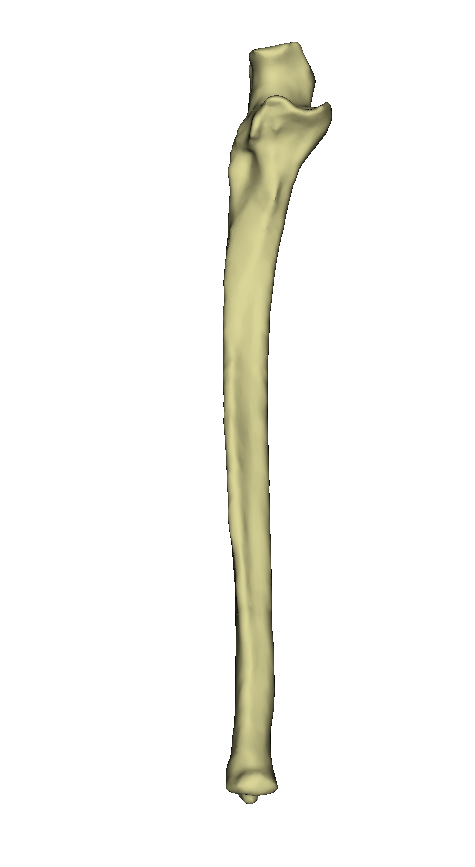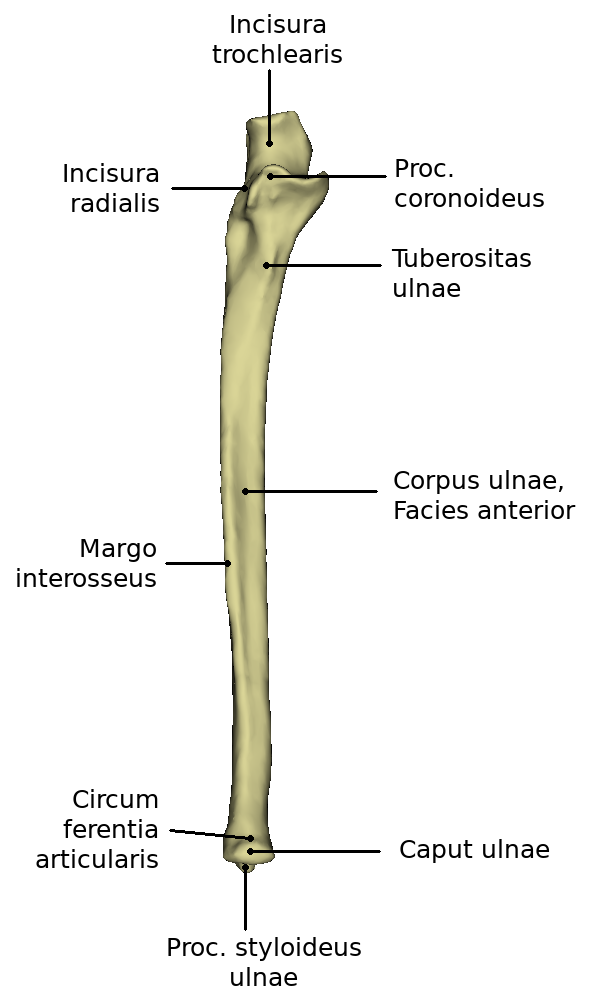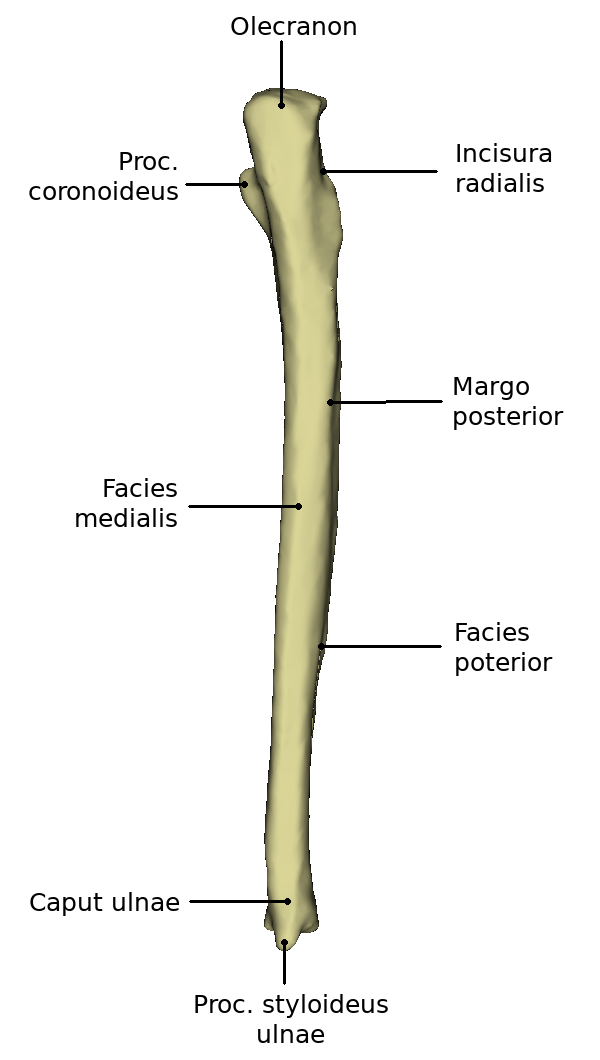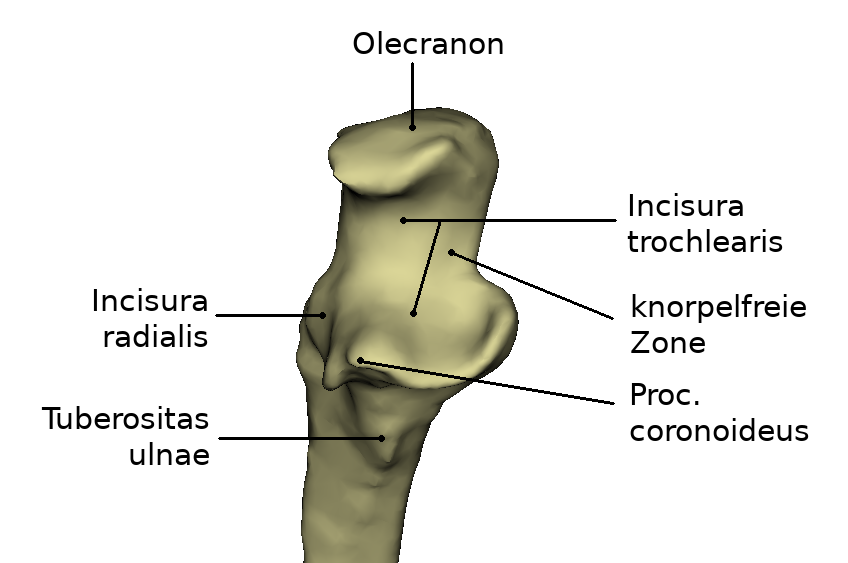Elle/en: Unterschied zwischen den Versionen
(Die Seite wurde neu angelegt: „=== Proximal end=== At the proximal extremity there is the hook-shaped bent extension, the olecranon. This has a certain roughness. In the front is the incisur…“) |
(Die Seite wurde neu angelegt: „==Ulna-Shaft=== The shaft of the ulna is also called the corpus ulnae. The cross-section of this structure has a triangular shape. Thus along the Corpus ulnae…“) |
||
| Zeile 50: | Zeile 50: | ||
At the proximal extremity there is the hook-shaped bent extension, the olecranon. This has a certain roughness. In the front is the incisura trochlearis (3), which reaches up to the processus coronoideus. This depression is crescent-shaped and resembles a pair of forceps. Dorsally of these structures a roughened surface is found on the ulna. This is the attachment surface of the M. brachialis, the tuberosity ulnae. Lateral is the incisura radialis, into which the circumferentia articularis (radii) is fitted. | At the proximal extremity there is the hook-shaped bent extension, the olecranon. This has a certain roughness. In the front is the incisura trochlearis (3), which reaches up to the processus coronoideus. This depression is crescent-shaped and resembles a pair of forceps. Dorsally of these structures a roughened surface is found on the ulna. This is the attachment surface of the M. brachialis, the tuberosity ulnae. Lateral is the incisura radialis, into which the circumferentia articularis (radii) is fitted. | ||
| − | + | ==Ulna-Shaft=== | |
| − | + | The shaft of the ulna is also called the corpus ulnae. The cross-section of this structure has a triangular shape. Thus along the Corpus ulnae there are three sides and edges. The Margo interosseus represents the side facing the spoke. This is where the Membrana interossea antebrachii, which connects ulna and spoke, comes in. Furthermore, this edge serves as separation of the posterior and anterior facies. At the posterior side of the ulna the Margo posterior runs. This runs from the olecranon down to the proc. styloideus at the caput ulnae. Adjacent to this edge are the posterior and medial facies. | |
| − | + | The medial surface does not have a continuous uniform shape. At the proximal end, the surface is significantly wider than at the distal end. The facies posterior also changes its structure over time. It has a broad and concavely curved part at the end close to the body. This changes in the middle to a narrower, convex surface. The distal end of this surface is then rounded and flat. | |
===Ulna-Kopf=== | ===Ulna-Kopf=== | ||
Version vom 26. Mai 2020, 13:10 Uhr
Together with the Radius the ulna forms the bones of the forearm. It is a typical long, straight tubular bone and lies on the side of the little finger in the arm.
Anatomy
The ulna has a corpus and one extremitas proximalis and distalis respectively. The Extremitas proximalis has a hook-shaped, roughened appendix, the Olecranon. In front is the Incisura trochlearis, which reaches up to the Processus coronoideus. Lateral is the Incisura radialis, into which the Circumferentia articularis (radii) is fitted.
Proximal end
At the proximal extremity there is the hook-shaped bent extension, the olecranon. This has a certain roughness. In the front is the incisura trochlearis (3), which reaches up to the processus coronoideus. This depression is crescent-shaped and resembles a pair of forceps. Dorsally of these structures a roughened surface is found on the ulna. This is the attachment surface of the M. brachialis, the tuberosity ulnae. Lateral is the incisura radialis, into which the circumferentia articularis (radii) is fitted.
Ulna-Shaft=
The shaft of the ulna is also called the corpus ulnae. The cross-section of this structure has a triangular shape. Thus along the Corpus ulnae there are three sides and edges. The Margo interosseus represents the side facing the spoke. This is where the Membrana interossea antebrachii, which connects ulna and spoke, comes in. Furthermore, this edge serves as separation of the posterior and anterior facies. At the posterior side of the ulna the Margo posterior runs. This runs from the olecranon down to the proc. styloideus at the caput ulnae. Adjacent to this edge are the posterior and medial facies. The medial surface does not have a continuous uniform shape. At the proximal end, the surface is significantly wider than at the distal end. The facies posterior also changes its structure over time. It has a broad and concavely curved part at the end close to the body. This changes in the middle to a narrower, convex surface. The distal end of this surface is then rounded and flat.
Ulna-Kopf
Der Ulna-Kopf oder auch Caput ulnae besitzt an seinem distalen Ende das Proc. styloideus ulnae. Dieser wird auch als Griffelfortsatz bezeichnet und befindet sich an der kleinfingrigen Seite der distalen Gelenkfläche. Das distale Ende ist im allgemeinen verbreitert im Gegensatz zu dem davor verlaufenden Schaft.
Funktion
Die Elle bildet eine funktionelle Einheit mit dem Radius. Durch sie entsteht die Verbindung zwischen Ellenbogen- und Handgelenk. Die Möglichkeit der Überkreuzung der zwei Knochen erlaubt die Drehbewegungen des Unterarmes und der Hand.
Entwicklung
Der Corpus ulnae beginnt bereits in der siebten Embryonalwoche zu verknöchern. Das Verschließen der Epiphysenfugen beginnt zwischen dem vierten und siebten Lebensjahr.







